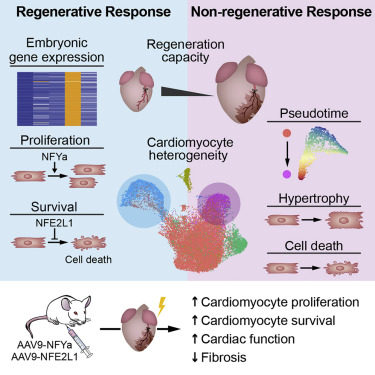Developmental Cell ( IF 10.7 ) Pub Date : 2020-03-26 , DOI: 10.1016/j.devcel.2020.02.019 Miao Cui 1 , Zhaoning Wang 1 , Kenian Chen 2 , Akansha M Shah 1 , Wei Tan 1 , Lauren Duan 1 , Efrain Sanchez-Ortiz 1 , Hui Li 1 , Lin Xu 2 , Ning Liu 1 , Rhonda Bassel-Duby 1 , Eric N Olson 1

|
The adult mammalian heart is incapable of regeneration following injury. In contrast, the neonatal mouse heart can efficiently regenerate during the first week of life. The molecular mechanisms that mediate the regenerative response and its blockade in later life are not understood. Here, by single-nucleus RNA sequencing, we map the dynamic transcriptional landscape of five distinct cardiomyocyte populations in healthy, injured, and regenerating mouse hearts. We identify immature cardiomyocytes that enter the cell cycle following injury and disappear as the heart loses the ability to regenerate. These proliferative neonatal cardiomyocytes display a unique transcriptional program dependent on nuclear transcription factor Y subunit alpha (NFYa) and nuclear factor erythroid 2-like 1 (NFE2L1) transcription factors, which exert proliferative and protective functions, respectively. Cardiac overexpression of these two factors conferred protection against ischemic injury in mature mouse hearts that were otherwise non-regenerative. These findings advance our understanding of the cellular basis of neonatal heart regeneration and reveal a transcriptional landscape for heart repair following injury.
中文翻译:

动态转录反应对单核RNA RNA测序揭示的再生和非再生心肌细胞的损伤。
成年哺乳动物的心脏在受伤后无法再生。相反,新生小鼠心脏可以在生命的第一周内有效地再生。介导再生反应及其在以后的生命中受阻的分子机制尚不清楚。在这里,通过单核RNA测序,我们绘制了健康,受伤和再生小鼠心脏中五个不同心肌细胞群体的动态转录景观。我们鉴定出未成熟的心肌细胞会在受伤后进入细胞周期,并随着心脏丧失再生能力而消失。这些增殖性新生儿心肌细胞显示出独特的转录程序,该程序依赖于核转录因子Y亚基α(NFYa)和核因子类红细胞2样1(NFE2L1)转录因子,分别发挥增殖和保护作用。这两个因素的心脏过度表达赋予了成熟小鼠心脏以防缺血性损伤的保护作用,否则这些小鼠将无法再生。这些发现提高了我们对新生儿心脏再生的细胞基础的理解,并揭示了损伤后心脏修复的转录方式。











































 京公网安备 11010802027423号
京公网安备 11010802027423号